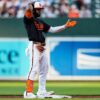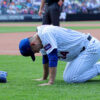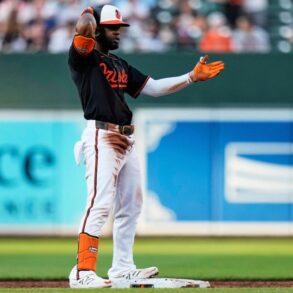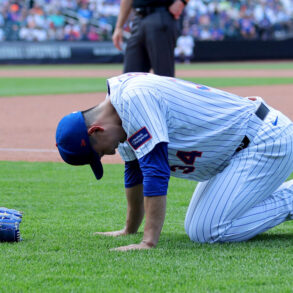They often say that working the fantasy baseball trade market is akin to playing the stock market.
It’s a fair comparison, as the most astute fantasy managers are usually quick to recognize the perfect time to trade a player. Oftentimes, the signs are there, be it weak underlying supporting metrics, the threat of an impending change in role, or the threat of past injury history. Whatever the reason, a subset of players is reminiscent of the ol’ game of “hot potato” — don’t be stuck with them when the music stops and their value dramatically plummets.
With that in mind, here are five players that you should be shopping right now:
Jacob Wilson, SS, Athletics: His has been quite a breakthrough story, as Wilson leads all rookies in wins above replacement, home runs, runs scored and RBI. He’s also second among all players to only Aaron Judge in batting average, and is the prohibitive betting favorite for American League Rookie of the Year honors. Wilson has become a mainstay in the upper third of the Athletics’ and fantasy lineups alike, and his ESPN roster rate is now over 85%.
That said, his style of elite contact, but with minimal quality, is one that’s rarely conducive to the caliber of numbers he’s putting up. Only two other players this century have had batting title-eligible seasons in which they had at most a 10% strikeout rate, at least a 50% ground ball rate, and at least a 10% HR/FB rate, as Wilson has so far: Randall Simon (2002) and DJ LeMahieu (2020), the latter doing so in the COVID-shortened year. Generally speaking, hitters of this ilk tend to produce empty batting averages, and little else, in fantasy terms.
Wilson has neither the blazing speed to maintain his lofty batting average — Statcast grades his sprint speed in the 39th percentile — nor the quality of contact needed to maintain his current 19-HR pace, as his hard-hit rate sits in the fourth percentile. He’s a handy, high-floor performer to slot at the back of a mixed-league lineup, but if your potential trade return nets a clear star, make the deal.
Tyler Mahle, SP, Texas Rangers: His first full season back following May 2023 Tommy John surgery couldn’t have gone much more smoothly than it has thus far. He ranks 11th in the majors in ERA and 28th among starting pitchers in fantasy points. The reason for that divide in rankings, however, represents a big reason for the skepticism: Mahle simply doesn’t strike out hitters at a rate we demand in present-day fantasy leagues. He ranks 57th among 76 ERA qualifiers in strikeout rate, and 65th among that same group in K-BB rate.
Add in Mahle’s injury history (which, in addition to elbow surgery, included a pair of IL stints in 2022 for shoulder issues) and there’s a workload concern for this pitcher who totaled 177 innings from 2022-24 but is on pace to throw more than that (186) in 2025 alone. His chip is one to cash in now, if you can get anything close to a similarly regarded, top-25 capable starting pitcher in exchange.
Roman Anthony, OF, Boston Red Sox: The most-added player in fantasy baseball over the past week, Anthony made his MLB debut on Monday night … and promptly went 0-for-4 while making an ugly, two-base error in right field. It was much a small-sample fluke as it was a reminder of the sizable adjustment demanded by the leap to the game’s highest competitive level, one that has held even the very tippity-top-ranked prospects in check during the opening weeks of their careers.
Taking only examples since the COVID-shortened 2020, as many as six universally regarded No. 1 prospects had at least a brief stint where they accrued merely “ordinary” numbers. It’s a list that includes Adley Rutschman (first 44 games in 2022), Bobby Witt Jr. (first 52 in 2022), Corbin Carroll (first 44 games in 2022-23), Gunnar Henderson (first 76 games in 2022-23), Jackson Holliday (his 60-game 2024 debut) and Elly De La Cruz (his 98-game 2024 debut). De La Cruz was the best of the bunch initially, averaging 2.0 fantasy points per game in the designated sample, while the five others — all of whom were better natural fits for ESPN’s standard points scoring system — all fell beneath that rate.
This isn’t to say that any of those six prospects took exceedingly long to click, nor that Anthony is destined to follow a similar, multiple-month pattern of lackluster statistics. Nor is this to remotely suggest that any Anthony manager in a dynasty or keeper format should consider trading him. But the upshot is that he’s in for quite a test over these next several weeks (especially with the crowded nature of the Red Sox’s outfield not affording him the lengthiest of leashes) while his perceived fantasy value couldn’t be higher than it is today.
See if Anthony could fetch you someone who has already arrived as a star, say, a Riley Greene or Wyatt Langford.
Robert Suarez, RP, San Diego Padres: So far, he’s formulating one of the greatest all-time cases of the follies of spring training statistics. A pitcher with a 15.43 ERA and .458 BAA during Cactus League play, Suarez is currently the major league’s leader in both saves and fantasy points among pure relief pitchers.
That said, much of Suarez’s success can be attributed to extreme good luck, most obviously represented by his .200 BABIP and 68.2% strand rate. However, Statcast adds further detail to this picture by revealing that Suarez has easily the widest wOBA-expected wOBA divide of any pitcher — 119 points in the wrong direction. To put that into perspective, no pitcher in the last 10 years who threw more than 70 innings has had a wider negative wOBA-xwOBA split than Matt Manning‘s 74-point deficit in 2023. Plus, Suarez has somehow surrendered six Barrels with zero home runs.
Suarez is probably the least-likely name on this list to crater statistically, but for all the positives of his closing for one of baseball’s most competitive teams, it also means he’s part of a bullpen chock full of alternatives should he succumb to any upcoming regression-driven struggles. He’ll be hard pressed to maintain a 50-save pace, and is worth shopping if you’re otherwise deep at closer.
Kris Bubic, RP/SP, Kansas City Royals: I want to believe this keeps up! Bubic is the MLB leader in ERA, fifth among starting pitchers in fantasy points per start, and his nine quality starts are tied for ninth. He has mostly maintained both his fastball velocity boost and high-quality sweeper from 2024. So why shop him, then?
It’s simple: Like Mahle, Bubic is a pitcher enjoying his first full season back following Tommy John surgery (April 2023). However, at 27, he’s three years younger than Mahle and therefore more likely to have his workload closely watched by the Royals. Bubic also finds himself on pace for a whopping 182 IP — a massive spike for a pitcher who hasn’t exceeded 130 IP in any single season since 2019.
The Royals have a wealth of SP talent, especially with rookie Noah Cameron shaping up as a viable rotation option, to slow Bubic’s pace in the coming weeks. However, that presents a twofold problem in the form of tougher tracking of his starts for our fantasy lineups, as well as the past examples of pitchers slowing statistically once teams begin to rein in their innings (see: Garrett Crochet in 2024).
Sometimes, such a pitcher is better used as a trade chip in exchange for an arm likely to deliver comparably good second–half numbers than keeping him around in the hope that he can defy the odds in the workload department.
This post was originally published on this site be sure to check out more of their content.







